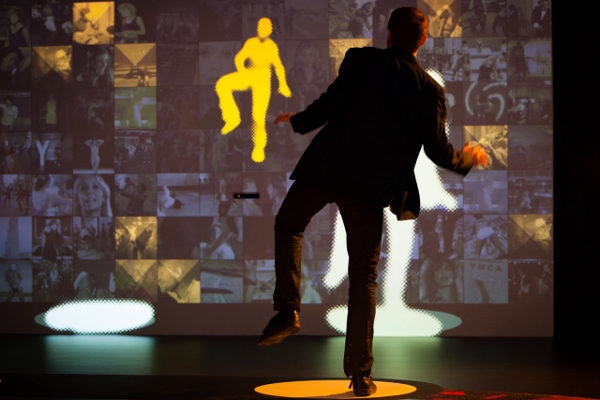|
The Danish town of Roskilde, approximately 30 minutes from Copenhagen, is home to the Roskilde Festival, one of the biggest music festivals in Europe drawing 130,000 people every summer for a week of camping, partying, music, drinking and cultural activities.
It is now also home to ‘Ragnarock’, a museum of rock, pop and youth culture. Opened in April, the attraction focuses on the evolution of music merged with youth culture from the 50’s to present day, and is housed in a building that suggests that this place is indeed like no other. The giant, golden, almost cathedral-like structure with a dramatic overhang and the dark red interior of the lobby certainly give a profound sense of arrival. The spectacular building was designed by Danish COBE and Dutch MVRDV. But, how do you display and communicate intangible stuff like ‘music’ and ‘youth culture’? I spoke with Sebastian Gyrst-Longsig Christensen of White Noise Agency, the creative force behind the museum’s concept and design. “Early on, we decided not to tell the story in a traditional, linear form. Instead, we focused on key aspects of the story and ended up with 11 themes such as fan culture, the concert experience, the recording studio, etc. The order of the themes is random, allowing us to take out themes and replace them with new in the future.” “Each of these themes then features what we call a ‘time carousel’, where we take a deeper look at the theme in 3 different decades. In the ‘dance room’, we explore the phenomena of dance by dipping into rock’n’roll, hip hop and rave.” The exhibits feature lengthy video interviews with people who were part of the scene and artefacts such as posters and clothing. For many visitors, however, the main attraction may be the dance floor, where you get to try to dance with a kinetic figure (top image) and see how good you are at throwing your hands up in the air at a rave party. Sex and Drugs and Rock’n’Roll Another theme deals with more controversial issues such as politics, sexuality and integration. “Sex, drugs and rock’n’roll didn’t come from nothing,” Sebastian says. “The music scene has always reflected new trends in society, be it gay rights, sadomasochistic sex or political views.” In this room, visitors get to see Anne Linnet’s stage costumes, which caused quite a stir in Danish society when she launched her band Marquis de Sade and started to sing about sadomasochistic relationships, complete with whips and leather corsets 80s style. A video features a recent interview with Linnet who also addresses what happened when she came out as a lesbian after the Marquis de Sade period. In the ‘light room’ visitors get to test lighting equipment, from 60s-style psychedelic liquid light shows to today’s video mapping. You can also put your head through a hole and view what an acid trip could look like. An Unorthodox Museum Experience “Basically, we wanted this to be an unorthodox museum experience. We have a lot of artefacts displayed in traditional, climate-controlled display cases, but the emphasis has been on giving people the overwhelming feeling of being part of music by using aggressive graphics, strong colours, interactive features and, of course, lots and lots of music,” Sebastian explains. “Each room has a giant, feature item, such as a massive mirror ball in the dance room or a huge cassette tape in the demo room, giving a clear sense of the theme.” Unusual in the museum industry, the Ragnarock attraction was designed without the help of an architect. “The majority of the design was done by graphic designer, Robert Nagy from Heavy TM, simply using Sketch Up, an inexpensive 3D modelling software. We had help with our interactive features by Jesper Harding and No Parking, who designed the attractions according to our brief.” The museum gives the visitor a feeling of leaving without having seen everything there is to see – with good reason. “If you hear every sound clip and see every video there is on display you’ll spend more than 24 hours in the museum,” says Sebastian. The museum, aiming to attract 50-60,000 visitors a year, admittedly features mostly Danish musicians. “Yes, our focus is Danish, but rock music has no borders,” says Sebastian. “It’s impossible to talk about youth culture without mentioning The Beatles or The Rolling Stones but the majority of the exhibits are Danish.” Which, in some cases, takes the Danish visitor on a sweet trip down memory lane. All text is in Danish and English however, and the museum will give the visitor to Denmark a unique insight into modern Danish culture. And, just like youth culture itself, the museum aims at being in constant development. “We have many new things in the pipe line,” Sebastian says. “One of the things we are looking at is making the toilets a part of the attraction by letting each toilet represent a different music venue. We are also planning a smaller, pop-up version of the museum to travel to the music festivals this summer.”
0 Comments
|
AuthorSome of the things I find on my way through life that I want to share Archives
April 2021
Categories |


 RSS Feed
RSS Feed

